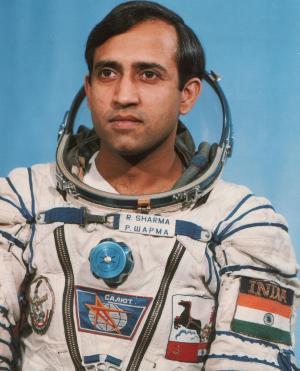Rakesh Sharma
Indian - (RFSA)
Retired
Date of Birth: Jan. 13, 1949
Age: 76
Rakesh Sharma (born 13 January 1949) is a former Indian Air Force pilot who flew aboard Soyuz T-11, launched on 2 April 1984, as part of the Interkosmos programme. Sharma is the first Indian citizen to travel in space.
Soyuz-U | Soyuz T-10
Russian Federal Space Agency (ROSCOSMOS) | RussiaBaikonur Cosmodrome, Republic of Kazakhstan
Feb. 8, 1984, 12:07 p.m.
Status: Success
Mission:
Soyuz T-10 was the third long-duration expedition to the Salyut 7 space station. The mission began on 8 February 1984, 12:07:26 UTC, launching Commander Leonid Kizim, Flight Engineer Vladimir Solovyov and Research Cosmonaut Oleg Atkov into orbit. They docked with the station the next day. During their 237-day stay on the station, crew performed various scientific and medical experiments, performed six EVAs for station maintenance, and were visited by Soyuz T-11 and Soyuz T-12 missions. Soyuz T-10, per usual, swapped vehicles with the Soyuz T-11 crew, which allowed for a longer stay on the station. The mission concluded with a safe landing back on Earth on October 2, 1984, 10:57:00 UTC.
Low Earth OrbitSoyuz-U | Soyuz T-11
Russian Federal Space Agency (ROSCOSMOS) | RussiaBaikonur Cosmodrome, Republic of Kazakhstan
April 3, 1984, 1:08 p.m.
Status: Success
Mission:
Soyuz T-11 was the sixth mission to visit the Salyut 7 space station and the first to visit the long-duration Soyuz T-10 resident crew of the station. The mission began on April 3, 1984, 13:08:00 UTC, launching Commander Yury Malyshev, Flight Engineer Gennady Strekalov and Research Cosmonaut Rakesh Sharma, the first Indian cosmonaut, into orbit. They docked with the station the next day. During their 7-day stay on the station, crew performed various scientific experiments. Soyuz T-11, per usual, swapped their vehicles with the resident Soyuz T-10 crew, which allowed for a longer stay on the station. The crew returned in Soyuz T-11 spacecraft, landing safely back on Earth on October 2, 1984, 10:57:00 UTC.
Low Earth OrbitThe Roscosmos State Corporation for Space Activities, commonly known as Roscosmos, is the governmental body responsible for the space science program of the Russian Federation and general aerospace research. Soyuz has many launch locations the Russian sites are Baikonur, Plesetsk and Vostochny however Ariane also purchases the vehicle and launches it from French Guiana.
Falcon 9
CSG-3
Space Launch Complex 4E - Vandenberg SFB, CA, USACSG-3 is an Earth observation satellite for the Italian Space Agency, part of a reconnaissance constellation using synthetic aperture radars operatin…
Long March 7A
Shijian 29 A-B
201 - Wenchang Space Launch Site, People's Republic of China2 satellites officially described as for "demonstration of new technologies for spatial targets detection" purposes.
Long March 4B
Tianhui 7
Launch Area 94 (SLS-2 / 603) - Jiuquan Satellite Launch Center, People's Republic of ChinaA satellite officially described as for cartography purposes, details TBD.
Soyuz 2.1b/Fregat-M
AIST-2T 01 & 02
Cosmodrome Site 1S - Vostochny Cosmodrome, Siberia, Russian FederationA pair of Russian optical Earth observation satellites built by the Progress Rocket Space Centre for obtaining stereo images of the Earth's surface, …
Long March 3B/E
Fengyun-4C
Launch Complex 2 (LC-2) - Xichang Satellite Launch Center, People's Republic of ChinaChina's geostationary meteorological satellite program FY-4 (Feng Yun 4) is the second generation of chinese geostationary meteorological satellites.



